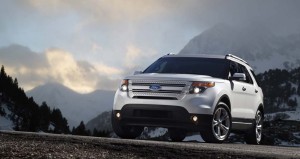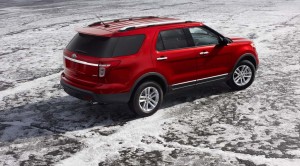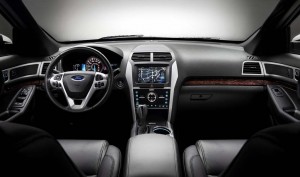You normally don’t expect to see Ford CEO Alan Mulally wandering through New York’s crowded Herald Square in the middle of a Monday morning. But this isn’t your typical weekday, not as far as Ford is concerned. The automaker’s chief executive is in the Big Apple for the launch of the latest, all-new version of the Ford Explorer.
Once the best-selling sport-utility vehicle in the world, Explorer is today just a shadow of its former self, at least from a sales standpoint, so the unusual preview – which bypasses the normal auto show circuit in a bid to maximize exposure from media-central Manhattan – is a critical step in Ford’s effort to rebuild demand.
“This is the reinvention of the most popular SUV in the world,” Mulally declared during an appearance on CNBC this morning. At least what was the top-selling SUV.
The original Explorer was one of the first to target the emerging market for light trucks, when it came to market two decades ago. But today, U.S. buying patterns have shifted once again, and sales of traditional truck-based sport-utility vehicles have fallen sharply, millions of buyers instead opting for lighter, more nimble and fuel-efficient crossover vehicles.
With the 2011 Explorer, Ford becomes the latest maker to shift from a body-on-frame to car-based platform – a strategy used by Mercedes-Benz, among others, with the latest-generation M-Class ute. But the Detroit maker is walking a marketing tightrope. At today’s launch and in the marketing blitz to follow, Ford will continue to play up the 2011 Explorer’s go-anywhere capabilities while also emphasizing its more crossover-like attributes – notably its more nimble ride and handling and a projected 30% improvement in fuel economy.
“It’s a vehicle completely redefined,” says Ford’s global product development director, Derrick Kuzak., with the goal of the redesign and shift to a CUV platform to address “past reasons for turning away” from both the SUV segment and Explorer, in particular.
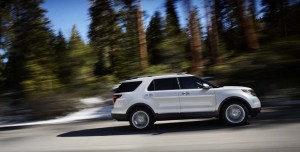
Ford will try to balance the 2011 Explorer's off-road capabalities with its new on-road manners and improved mileage.
Fuel economy, Kuzak acknowledged, has been the number one downfall of the sport-ute segment. But simply getting mileage up wouldn’t be enough to revive Explorer, which in 2000 accounted for sales of 445,000 vehicles – but which clocked volume of just 52,000 in 2009. And that means Ford is loading the new 2011 model up with an array of safety, comfort and performance features, including the all-new I4 version of its EcoBoost engine.
The new Explorer is actually a bit bigger than before, with an extra 5 inches of width, 3 inches in length and 8 inches in track. That provides more space for passengers – and a third row. The wheelbase is actually down an inch, while ground clearance comes in at 8 inches, more than enough for even moderately serious off-roaders.
Significantly, the added measurements don’t add up to more mass. With the 3.5-liter V6 that comes standard, the 2011 Ford Explorer weighs in about 100 pounds less than with the old 4.0-liter six.
The new base engine will get about 20% better mileage than the old powertrain, but expect Ford to put an emphasis on the alternative, the maker’s first application of an all-new 2.0-liter EcoBoost. This turbocharged inline-four is expected to bump mileage up to 18 City, 26 Highway – though final EPA-approved numbers have yet to be released. Significantly, with 237 horsepower and 250 pound-feet of torque, the EcoBoost is expected to still deliver significant towing and performance capabilities.
Those are details the public should like, insists Jim Farley, Ford’s global marketing czar, who says “My job is to myth-bust…to re-engage people” who have written off not just the Explorer but the SUV segment overall.
That’s a key reason for the unusual launch to the campaign, he adds. “We decided to take the engagement and the excitement of the product, and make it a bigger deal than just an auto show,” where Explorer would also have to share media attention with a number of other new products.
Though today marks the official introduction of the 2011 Ford Explorer, the automaker has been carefully building up a drumbeat for more than a year, starting in 2009, when it announced the new ute would be the first vehicle to come equipped with rear seatbelts that incorporate airbags in their webbing, a way to reduce injuries particularly to the very young and old.
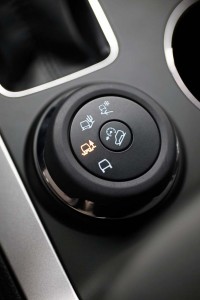
The new Terrain Management Control allows users to instantly switch to the right brake, engine, transmission and other settings depending on road conditions.
Since then, Ford has announced a number of other safety enhancements for the 2011 Explorer, such as its new Curve Control system, a variation of the now-popular stability control, but here able to reduce the likelihood of an accident if a motorist goes into a corner too aggressively.
A feature likely to appeal to off-roaders and “soft-roaders” alike is the new Terrain Management Control — borrowed from Ford’s former Land Rover subsidiary — which allows a driver to choose from four different road settings. The system automatically adapts by adjusting such things as brakes, throttle input, gear shifts and stability control functions.
Explorer will also get an array of creature comfort features, including the latest version of Ford’s popular Sync voice-controlled infotainment system. Significantly, all but the lowest-priced Explorer SEL model will get basic Sync, including turn-by-turn navigation. And motorists will be able to upgrade to a full-color navi system for just $795, significantly below what most competitors currently charge.
The top-level navigation system also provides additional Sync features, such as the ability to display album art for music played through the system.
Will these and Explorer’s other new features draw in the crowds like earlier generations of the SUV did? Industry analysts take a cautious approach, noting, among other things, the massive increase in competition in both the SUV and CUV segments since Explorer hit its peak in the Millennial model-year. Ford itself now offers not just Explorer but also the Edge crossover and the Flex “people mover.” And though Ford officials insist each appeals to a different buyer group, they’ve all drawn former Explorer owners over the years.
Meanwhile, Chrysler’s only significant launch for the start of 2011 is an all-new version of its own Jeep Grand Cherokee. While it won’t yield quite the mileage of the Explorer, the Jeep has been getting solid initial reviews.
But Farley believes that Ford has momentum on its side. It has been scoring big in virtually every recent survey that matters, from those that measure quality, such as the J.D. Power Initial Quality Survey, to those that look at more emotional factors, like the AutoPacific Ideal Vehicle Awards, where Ford alone took more segment awards than the Japanese, Koreans and Europeans did collectively.
The fact that Ford risked its survival by mortgaging most of its assets and skipping a federal bailout also hasn’t hurt, adds Farley, suggesting, “If people like your company…they’re more inclined to shop your products.”
Can the 2011 Ford Explorer regain its former momentum? Unlikely, company insiders admit. Sales in the 400,000 range are all but certainly a thing of the past. And even hitting 100,000 may be a challenge, they quietly concede, though Ford declines to put out a formal sales forecast for the new ute. But demand in the U.S. could be supplemented by growth abroad, and there the switch from truck to crossover could prove even more significant, Farley notes.

